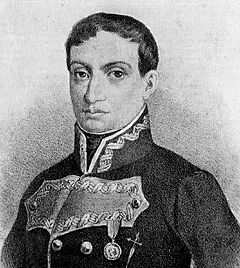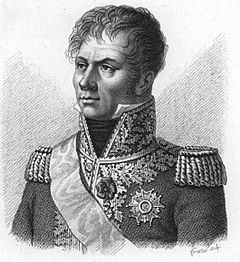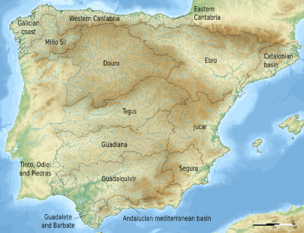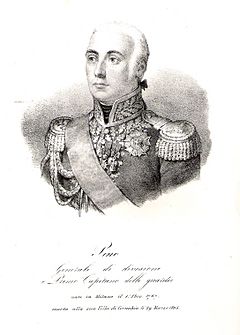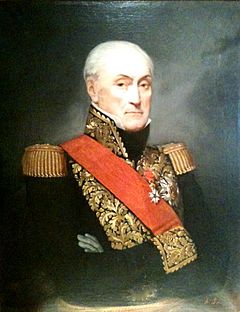Battle of Cardedeu facts for kids
Quick facts for kids Battle of Cardadeu |
|||||||
|---|---|---|---|---|---|---|---|
| Part of Peninsular War | |||||||
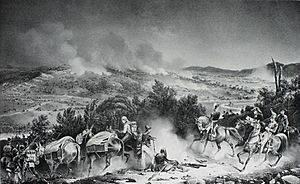 Battle of Cardedeu, 16 December 1808, by Jean-Charles Langlois. |
|||||||
|
|||||||
| Belligerents | |||||||
| Commanders and leaders | |||||||
| Strength | |||||||
| 15,000–16,500, 30 guns | 9,000, 7 guns | ||||||
| Casualties and losses | |||||||
| 600 | 2,500, 5 guns, 2 colors | ||||||
The Battle of Cardadeu happened on December 16, 1808. It was a fight between the French and Italian armies, led by Laurent Gouvion Saint-Cyr, and a Spanish army. The Spanish forces were commanded by Juan Miguel de Vives y Feliu and Theodor von Reding. Saint-Cyr's troops won by attacking in large columns, breaking through the Spanish lines.
This battle took place near Cardedeu, about 17 kilometers (10.5 miles) northeast of Barcelona, Spain. It was part of the Peninsular War, which was a big conflict during the Napoleonic Wars.
By late 1808, a French army led by Guillaume Philibert Duhesme was trapped in Barcelona. A Spanish army of about 24,000 soldiers, led by Vives, surrounded them. To help Duhesme, Saint-Cyr marched from France with 23,000 French and Italian soldiers. First, Saint-Cyr successfully attacked Roses. Then, he faced the strong fortress of Girona. Instead of attacking it, he took a big risk. He left his heavy guns and most supplies behind. He marched 16,500 men through the mountains towards Barcelona.
Saint-Cyr was very clever and surprised Vives. Vives could only gather about 9,000 troops to stop him. Vives placed his smaller army on high ground. But Saint-Cyr's huge attack columns were too strong. The Spanish army had to retreat after losing many soldiers. Soon after, Barcelona was freed from the Spanish blockade.
Contents
Why the Battle Happened
The Dos de Mayo Uprising in May 1808 started a rebellion against French rule in Spain. This led to the Peninsular War. Spain had some early wins, but Emperor Napoleon invaded Spain. His army successfully took over Madrid. The Battle of Cardadeu was an important part of Napoleon's invasion.
French Problems in Spain
In February 1808, Napoleon planned to take control of Spain. His forces captured several key places, including Barcelona. Other cities like San Sebastián, Pamplona, and Figueras were also taken by clever tricks. But on May 2, 1808, the Spanish people rose up against the French. This event is known as the Dos de Mayo Uprising.
In the summer of 1808, a French army of about 12,710 soldiers, led by General Guillaume Philibert Duhesme, was in Barcelona. This army was supposed to stop the rebellion in Catalonia. They also needed to help another French general capture Valencia and hold Barcelona. But the rebellion was very strong, and these orders were hard to follow.
Duhesme's troops faced several defeats. They were beaten at the Battles of the Bruch in June. Duhesme also failed to capture Girona in July and August. News of a major French defeat at the Battle of Bailen in July made the Spanish feel stronger and the French feel weaker. Duhesme's soldiers had to fight their way back to Barcelona. They even had to leave their heavy guns behind. They finally reached Barcelona on August 20.
Meanwhile, Spanish troops from the Balearic Islands arrived. Along with thousands of Catalan militia (called miquelets), they started to surround Barcelona in August. On July 31, they captured a castle near Barcelona with help from a British ship. Duhesme's 10,000 remaining soldiers were in a tough spot. However, the Spanish commander, Marquis del Palacio, did not attack them very hard. The French could still send groups out to find food and supplies.
Because Del Palacio was not active enough, the Spanish leaders replaced him. Juan Miguel de Vives y Feliu took over on October 28. Vives was an experienced general. He pushed the French back into Barcelona's walls on November 26, causing about 100 French losses. But then he waited for more Spanish troops to arrive, led by General Theodor von Reding.
Saint-Cyr Takes Over
After the problems in the summer, Napoleon chose Laurent Gouvion Saint-Cyr to replace Duhesme on August 17, 1808. Napoleon also sent two strong divisions from Italy to help Saint-Cyr's army. These were led by General Joseph Souham (French soldiers) and General Domenico Pino (Italian soldiers).
Saint-Cyr was a very skilled general. His soldiers respected him, but he was not very friendly. He also tended to let other generals figure things out on their own. Saint-Cyr did not like Napoleon, which had slowed down his career. Even though he later wrote that Napoleon wanted him to fail, Napoleon made him a top general in 1812. Saint-Cyr's new troops arrived slowly, and there were delays with supplies. Finally, on November 5, Saint-Cyr's army crossed the Pyrenees mountains into Spain.
Saint-Cyr's army had about 42,000 soldiers in total. But many were sick, wounded, or on other duties. About 10,000 of his soldiers were already trapped in Barcelona with Duhesme. So, Saint-Cyr had about 15,000 foot soldiers and 1,500 horsemen for his main force.
When Saint-Cyr met Napoleon, he was told that freeing Barcelona was the most important goal. Napoleon said Barcelona could last until the end of December. Saint-Cyr decided he had to capture the port of Roses first. The Siege of Roses lasted from November 7 to December 5, 1808. It was successful but cost the French about 1,000 soldiers.
With Roses captured, Saint-Cyr could focus on Barcelona. He left some troops to guard Roses and the roads from France. Then, he marched his army towards Barcelona. The city of Girona was directly in his way. Saint-Cyr knew he could not waste time besieging Girona. Barcelona would run out of food if he did. He decided to bypass Girona. There were two roads: one along the coast and one inland. The coast road was dangerous because British ships could attack it. So, Saint-Cyr chose the inland road. He hoped to keep the Spanish general Vives guessing and defeat him quickly.
The Battle of Cardadeu
French Attack
On November 9, 1808, Saint-Cyr gathered his army near the Ter River, across from Girona. The next day, he moved towards Girona as if to attack it. He wanted the Spanish generals, Álvarez and Lazán, to come out and fight. But they knew their 8,000 men would be crushed, so they stayed put. On November 11, Saint-Cyr sent his heavy guns and supply wagons back to Figueras. He then marched his army to La Bisbal d'Empordà. Each soldier received four days of food and carried 50 rounds of ammunition. Mules carried another 10 rounds per soldier. Saint-Cyr was taking a huge risk. If his army stayed too long in the mountains, they would starve. If they fought too many battles, they would run out of bullets.
On November 12, the French and Italian troops passed near Palamós. They fought their way through some Catalan militia led by Juan Clarós. On November 13, Saint-Cyr's army reached Vidreres, which was near the coast road. That evening, they saw enemy campfires to the north and south. But Saint-Cyr knew a secret path through the mountains. This path connected the coast road to the inland road. On November 14, Saint-Cyr himself went to find the path with a small group. He found it, even though they almost got captured by local fighters.
On November 15, the entire French and Italian army moved through the hills. They bypassed the small fortress of Hostalric and reached the inland road at Sant Celoni. There, they defeated a group of militia. Even though his men were tired, Saint-Cyr pushed them along the road. They passed through a dangerous narrow pass called Trentapassos, which was empty. That evening, they saw Spanish campfires ahead, meaning the Spanish army was there.
The Spanish general Vives quickly learned about Saint-Cyr's march. Vives sent Reding with 5,000 men to watch the inland road. Another general, Milans, with 3,000 volunteers, was ordered to block the coast road. But Vives kept about 16,000 troops to continue blocking Barcelona. Milans moved to Sant Celoni, where his men were defeated. This news on November 15 finally made Vives take another 4,000 men. He marched through the night to join Reding by dawn on December 16, 1808. The remaining 12,000 Spanish troops continued to block Duhesme in Barcelona.
So, Saint-Cyr's 16,500 troops faced only 9,000 Spaniards under Vives. Milans and his 3,000 men were recovering to the east. Another Spanish general, Lazán, with 6,000 men, was somewhere to the north. Saint-Cyr had 30 cannons, while Vives had only 7.
The Fight
The battle took place between Llinars del Vallès and Cardedeu. The Mogent River flows through this area. Vives arrived that morning and did not have much time to plan his defense. He placed his first line of soldiers behind a stream called Riera de la Roca. His second line was further uphill. Reding's division held the right side of the Spanish line. Vives defended the center and left with his Catalan troops. They had three cannons on a hill in the center, two on the left, and two with their reserve troops. The area had many trees and fields, making it hard to see enemy movements.
Saint-Cyr knew he had to act fast. His soldiers had eaten their last food, and ammunition was low. Any delay would allow Lazán's Spanish troops to catch up from behind. Saint-Cyr ordered General Chabot to hold a narrow pass with three battalions. Then, Saint-Cyr decided to break through Vives' lines with his remaining 23 battalions. Pino's Italian division was in front, followed by Souham's French division. Saint-Cyr told Pino to keep his soldiers in tight columns and smash through the enemy lines with pure force. Pino was not allowed to spread out his soldiers, not even to take prisoners.
As Pino's narrow column moved forward, it came under heavy fire from the sides. Pino ignored his orders and sent some of his soldiers to the right and left. His attack broke the first Spanish line but stopped at the second line, halfway up the hill. Reding ordered a cavalry charge and sent his whole line forward. Pino's Italian soldiers struggled and were pushed back.
Just then, Saint-Cyr arrived and saw his first attack failing. He immediately ordered Souham's 10 French battalions to move left and attack Reding's right side. He also sent Pino's other soldiers to attack the Spanish center. The other French troops continued to distract the Spanish left. Souham's strong column crashed into Reding's line and broke it. At the same time, Pino's second group pushed back the Spanish center.
As the Spanish defense fell apart, Saint-Cyr ordered the Italian cavalry to charge up the main road. As the horsemen galloped up the hill, the entire Spanish army ran away.
The French and Italian troops killed or wounded 1,000 Spanish soldiers. They also captured 1,500 Spanish prisoners, five cannons, and two flags. Saint-Cyr reported that his army lost 600 men, mostly Italians. Reding almost got captured while trying to rally his soldiers. Vives left his horse and escaped up a cliff. He reached the coast and was taken away by a British ship to Tarragona. Milans arrived after the battle was over. Lazán never reached the battle area. After hearing the bad news, Lazán marched his troops back to Girona.
What Happened Next
On December 16, the Spanish general Caldagues stopped Duhesme from breaking out of Barcelona. But that night, when Caldagues learned that Vives had been defeated, he gave up the blockade. He moved his troops back behind the Llobregat River. The Spanish army left behind large amounts of food at Sarrià. On December 17, 1808, Saint-Cyr's winning army marched into Barcelona. Saint-Cyr later said that Duhesme did not even thank him. Duhesme even claimed Barcelona could have held out for six more weeks. Saint-Cyr then showed him a copy of Duhesme's own messages, begging for immediate help. The fighting was not over yet. On December 21, Saint-Cyr's army fought Vives, Reding, and Caldagues again at the Battle of Molins de Rey.
See also



